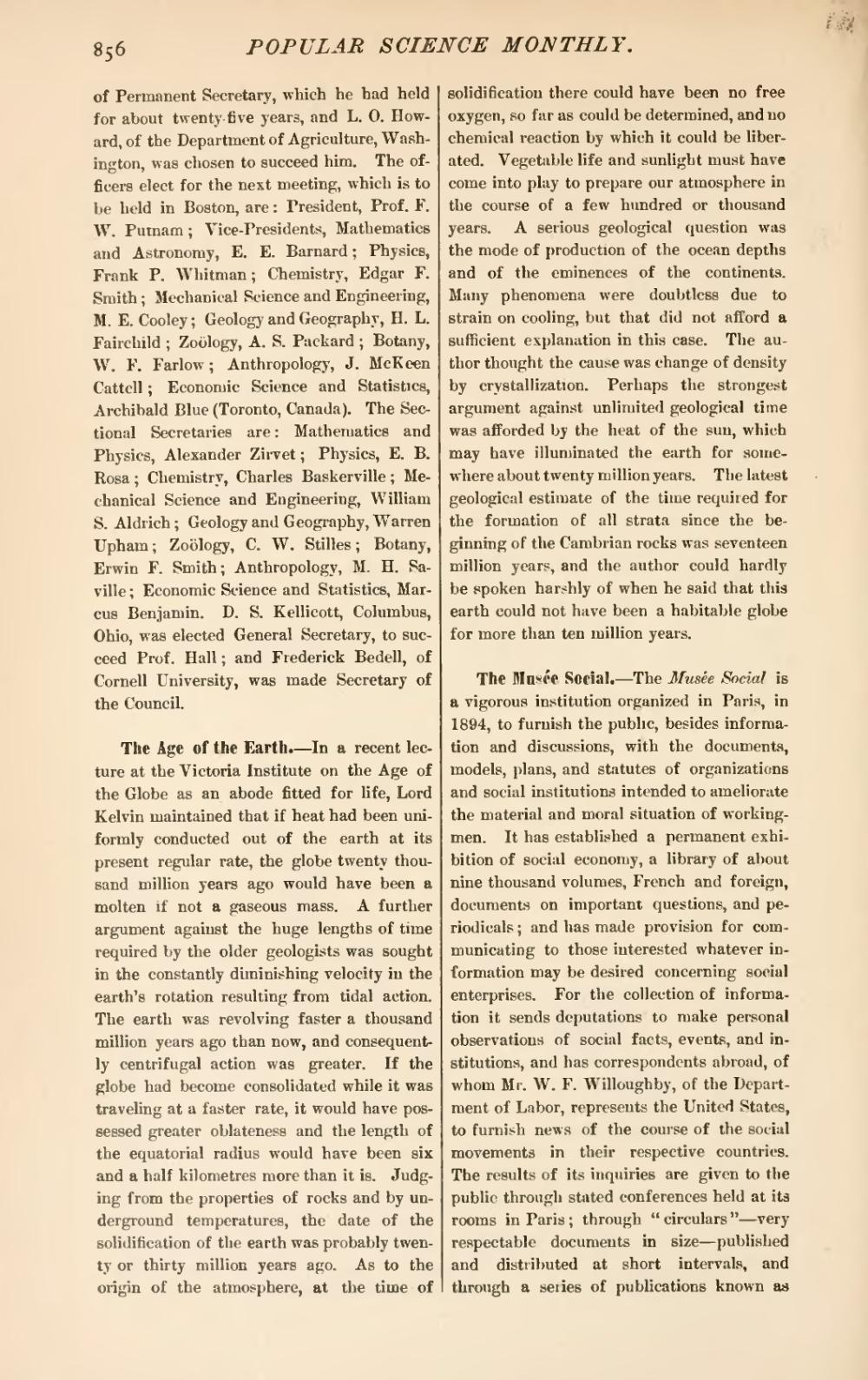of Permanent Secretary, which he had held for about twenty-five years, and L. O. Howard, of the Department of Agriculture, Washington, was chosen to succeed him. The officers elect for the next meeting, which is to be held in Boston, are: President, Prof. F. W. Putnam; Vice-Presidents, Mathematics and Astronomy, E. E. Barnard; Physics, Frank P. Whitman; Chemistry, Edgar F. Smith; Mechanical Science and Engineering, M. E. Cooley Geology and Geography, H. L. Fairchild; Zoölogy, A. S. Packard; Botany, W. F. Farlow; Anthropology, J. McKen Cattell; Economic Science and Statistics, Archibald Blue (Toronto, Canada). The Sectional Secretaries are: Mathematics and Physics, Alexander Zirvet; Physics, E. B. Rosa; Chemistry, Charles Baskerville; Mechanical Science and Engineering, William S. Aldrich; Geology and Geography, Warren Upham; Zoölogy, C. W. Stille; Botany, Erwin F. Smith; Anthropology, M. H. Saville; Economic Science and Statistics, Marcus Benjamin. D. S. Kellicott, Columbus, Ohio, was elected General Secretary, to succeed Prof. Hall; and Frederick Bedell, of Cornell University, was made Secretary of the Council.
The Age of the Earth.—In a recent lecture at the Victoria Institute on the Age of the Globe as an abode fitted for life, Lord Kelvin maintained that if heat had been uniformly conducted out of the earth at its present regular rate, the globe twenty thousand million years ago would have been a molten if not a gaseous mass. A further argument against the huge lengths of time required by the older geologists was sought in the constantly diminishing velocity in the earth's rotation resulting from tidal action. The earth was revolving faster a thousand million years ago than now, and consequently centrifugal action was greater. If the globe had become consolidated while it was traveling at a faster rate, it would have possessed greater oblateness and the length of the equatorial radius would have been six and a half kilometres more than it is. Judging from the properties of rocks and by underground temperatures, the date of the solidification of the earth was probably twenty or thirty million years ago. As to the origin of the atmosphere, at the time of solidification there could have been no free oxygen, so far as could be determined, and no chemical reaction by which it could be liberated. Vegetable life and sunlight must have come into play to prepare our atmosphere in the course of a few hundred or thousand years. A serious geological question was the mode of production of the ocean depths and of the eminences of the continents. Many phenomena were doubtless due to strain on cooling, but that did not afford a sufficient explanation in this case. The author thought the cause was change of density by crystallization. Perhaps the strongest argument against unlimited geological time was afforded by the heat of the sun, which may have illuminated the earth for somewhere about twenty million years. The latest geological estimate of the time required for the formation of all strata since the beginning of the Cambrian rocks was seventeen million years, and the author could hardly be spoken harshly of when he said that this earth could not have been a habitable globe for more than ten million years.
The Musée Social.—The Musée Social is a vigorous institution organized in Paris, in 1894, to furnish the public, besides information and discussions, with the documents, models, plans, and statutes of organizations and social institutions intended to ameliorate the material and moral situation of workingmen. It has established a permanent exhibition of social economy, a library of about nine thousand volumes, French and foreign, documents on important questions, and periodicals; and has made provision for communicating to those interested whatever information may be desired concerning social enterprises. For the collection of information it sends deputations to make personal observations of social facts, events, and institutions, and has correspondents abroad, of whom Mr. W. F. Willoughby, of the Department of Labor, represents the United States, to furnish news of the course of the social movements in their respective countries. The results of its inquiries are given to the public through stated conferences held at its rooms in Paris; through "circulars"—very respectable documents in size—published and distributed at short intervals, and through a series of publications known as
